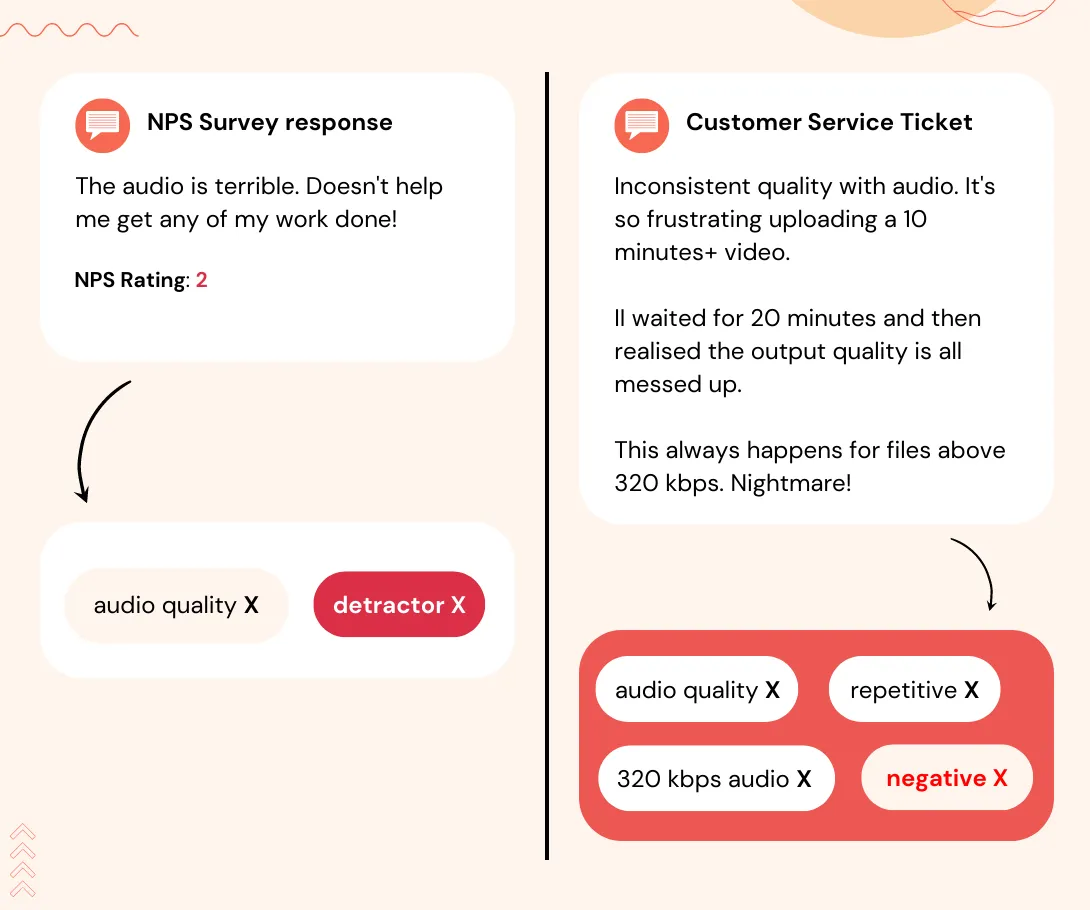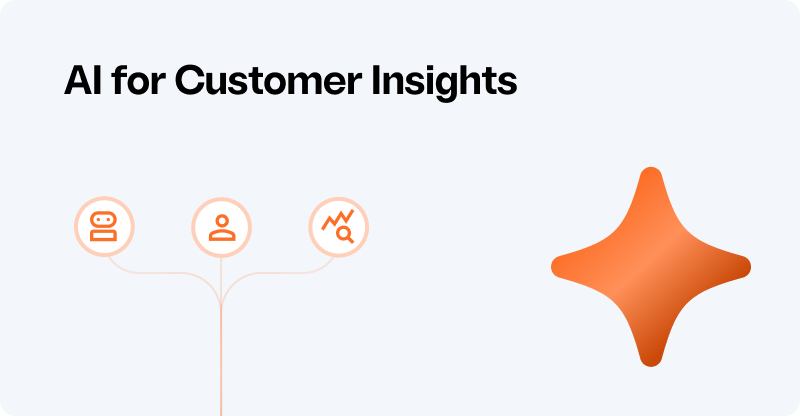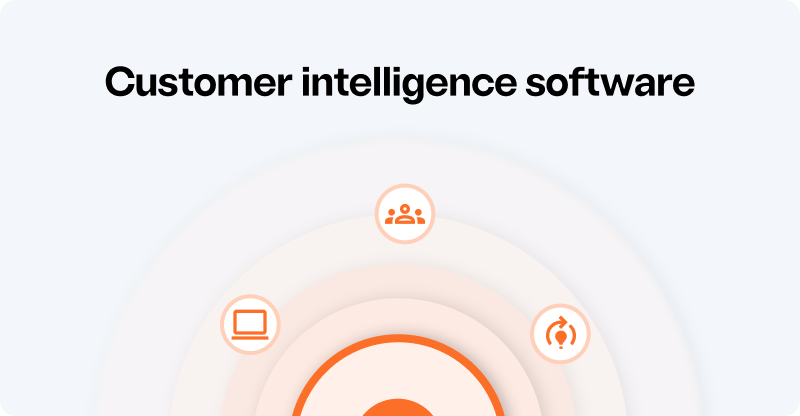NPS surveys are windows into what customers think about your brand.
But they are not enough to understand those areas of concern that are bringing your NPS down.
What you need is to supplement your NPS analysis with sentiment analysis of customer conversations.
Together, these two can give you granular insights into how your customers are feeling at every touchpoint, and why they're giving a low (or a high) NPS score.
In this article, we’ll look at why and how you can conduct NPS sentiment analysis with a holistic sentiment analysis tool.
Jump to:
- What is NPS Sentiment Analysis? And Why Does it Matter?
- 5 Steps to Conduct NPS Sentiment Analysis [Using Software]
- 5 Ways NPS and Customer Sentiment Analysis Can Drive Change & Improvement
What is NPS Sentiment Analysis? And Why Does it Matter?
NPS sentiment analysis is the process of understanding the sentiment—positive, negative, or neutral—of NPS surveys and all customer conversations (emails, chats, reviews, phone calls, and more).
This helps Support Leaders understand:
- Why a customer left them a bad (or a good) score
- What are the key issues driving negative scores
Why do you need an additional layer of customer sentiment analysis?
Because you can’t improve NPS by just looking at the score—you need to understand (and fix) the key drivers of low NPS scores.
And to understand these key drivers, you need to look at all your customer conversations, not just NPS.
The Old Way of Doing NPS Analysis is Dead
The current method of analyzing NPS in a silo is causing more harm than good, largely due to the way NPS is collected in the first place.
Typically, companies send out surveys to their customers asking them to rate them on a scale of 10 based on the likelihood of them recommending it to others.
This is often followed up with a close-ended question asking the customers to provide an explanation for the particular rating they provided.

This is a simple and easy way of understanding NPS, but it doesn’t tell you the key NPS drivers you need to improve NPS.
Why? Four reasons:
- NPS surveys are biased: A follow-up question to an NPS score will only capture a small part of the customer’s journey. It doesn’t shed any light on the previous experiences that led to such a score.
- NPS surveys are reactive: Detractors share their issues only after it’s troubled them to a point where they feel highly negatively about it. At this point it is too late. If you can proactively track and solve customer issues, then customers won’t even turn into detractors in the first place.
- NPS surveys are not complete: While it's great to rejoice when a promoter gives you the perfect score, it’s also important to understand those nagging issues that they are facing and take proactive steps to fix them. Promoters do not share that information in NPS surveys.

- NPS surveys have a low completion rate: NPS surveys, like most surveys, are often unanswered. The industry standard is in single digits. Such a short data sample means that the insights do not reflect or match what the majority is thinking.
So, what’s the solution?
Why You Need Customer Sentiment Analysis to Improve NPS
A bad NPS (or a good one) is decided by a culmination of all the experiences that your customers had with your company up until that point.
To understand all these experiences, you need a holistic approach–customer sentiment analysis on top of NPS analysis.
Customer sentiment analysis can help you figure out exactly how your customers are feeling about your product, company, or service.
And the most authentic form comes from analyzing your customer service conversations—support tickets, emails, chats, calls, and more.
Customer service data tell you the story of your customer's journey with your company and enable you to connect those dots between a bad experience (or a series of bad experiences) and a low NPS rating.
.webp)
Here’s why customer sentiment is key to improving NPS and customer experience as a whole:
- It’s granular: The biggest benefit of customer service conversations is that it provides richer customer data. Since the data is detailed, the insights are also granular and actionable.

- It’s proactive: If you use customer insights from throughout their journey, you can fix topics of concern before they become huge risks. This way you can prevent customers from turning into detractors and leaving you a terrible score.
- It’s holistic: Customers share their concerns with customer service without being asked, which means that the data is all-encompassing and not restricted to limited questions or aspects.
Now that you know why you need customer insights, we’ll show you how to get them.
📖 Read more: 6 Best Customer Sentiment Analysis Tools in 2024
5 Steps to Conduct NPS Sentiment Analysis [Using Software]
The easiest way to analyze NPS and customer sentiment analysis is to use a dedicated tool.
For instance, our software, SentiSum, lets you analyze customer conversations from ALL channels—the traditional ones like NPS surveys, emails, chats, and the more obscure ones like phone calls.

When you can analyze everything in one place, you can map NPS scores to conversation data easily.
Let’s look at how SentiSum works in detail:
1. Compile and Analyze Customer Data From All Channels
First, SentiSum brings in customer data from all conversation and feedback channels seamlessly.
All you need to do is choose a data source and authenticate the connection:

Explore the full list of integrations here.
2. AI analyzes customer conversations and feedback.
Next, SentiSum uses machine-learning based NLP to automatically analyze customer conversations and gives you insights into:
- Key topics (e.g. Refunds)
- Sentiment (e.g. Positive, negative, or neutral)
- Urgency
- Intent
Our Chief Product Officer, Kristy Pinner, explains why AI is better than humans in this aspect.
“AI can cut through the subjectivity of human opinion, and no matter how something is said, it can report on the customer issue in a simple way.”
3. See Key Negative Sentiment Drivers on the Dashboard
Once the analysis and tagging process is done (usually takes seconds), SentiSum’s easy to use dashboard shows all the key insights, like:
- Trend of customer sentiment over time
- Main issues for contact (we call them “topics”)
- Top negative and positive sentiment drivers

Once you know the key negative drivers, you can plan to fix these issues at the very root—improving NPS scores in the long run.
4. Tie Each Customer Conversation to NPS Scores
To dig deeper into a key negative sentiment driver (e.g. Parking Space Availability), you can just click on it. SentiSum will show you:
- Trend over time
- Breakdowns of conversations mentioning this issue
- Details of each conversation
- AI chatbot called “Dig In” - which allows you to ask questions and get succinct, summarized answers


If you want to understand why a customer left you a low NPS score, you can easily look up past interactions they had with you. This way, you can find out what issues bothered them and make plans to fix them.
5. Save Time and Answer Ad-Hoc Questions Fast with AI Summaries
It’s simply not feasible to sift through all your NPS surveys when you get specific inquiries from your colleagues about the results.
Dig In, SentiSum’s ChatGPT-like AI feature, provides succinct answers about your voice of customer data.
Select a pre-prompted question or write your own, and you’ll get succinct, summarized answers, without manually sifting through data.
This means you can quickly answer ad-hoc questions from other teams or C-Suite and use data to back up your answers.

So, you’ve got all the insights. What now?
6 Ways NPS and Customer Sentiment Analysis Can Drive Change & Improvement
The sole purpose of NPS sentiment analysis is to improve NPS scores. It does this in 6 key ways:
1. Understand Key NPS Drivers and Improve Customer Experience
It’s difficult to understand what’s driving a low NPS score if you can’t assess the entire journey a customer has had with you.
And what you can’t understand, you can’t improve.
NPS sentiment analysis helps uncover what customers think about you at every touchpoint, and shows you what went wrong, so you can start to improve upon those issues.
For instance, when British Airways Holidays wanted to understand their key NPS drivers, they decided to analyze 100,000 of reviews customers have left for them on various platforms.
But without a dedicated tool, the BA Holidays team was sifting through hundreds of reviews using a keyword search for the complaints they wanted to avoid.
This was tedious, time-consuming, and prone to errors.
When they started working with SEntiSum, our machine-learning identified when specific customer issues were mentioned in reviews, flagging them for action by the BA Holiday team.
In 5 minutes, the team was able to uncover both negative and positive drivers of NPS.
If particular topics arose in the reviews, they could then look at the individual reviews and identify which hotels were contributing to negative customer sentiment.
This meant that British Airways could proactively work with the hotels to prevent further negative experiences.
With the keyword search used previously, only 15% of reviews were actually relevant. But, with SentiSum's NLP 95% of the reviews flagged to the team contained valuable information for improving customer experience.
2. Closely Track Topic and Sentiment Trends Over Time
NPS scores can fluctuate, and you might not know for sure whether specific actions are influencing those numbers.
SentiSum’s topic and sentiment trend monitoring features provide clear insights into customer concerns and the impact of implemented changes over a period of time.
For instance, British Airways used SentiSum to proactively manage and mitigate issues before they escalated.
"[SentiSum allowed] us to quickly identify very recent feedback that indicates a customer experienced unexpected work taking place at a hotel that has impacted their stay,” said the Head of Customer Service at British Airways.
This continuous oversight helps ensure minor issues don't turn into major problems that could hurt your reputation or drive customers away.
3. Know Exactly Which Product Feature / Service to Improve Upon
Which product features or services are failing to meet customer expectations?
It can be tough to pinpoint the answer without precise data.
SentiSum uses AI to create detailed tags from NPS survey data to give you a better idea of key customer pain points.
Hotjar used these capabilities to prioritize changes effectively.
"We … use [SentiSum] insights to inform our conversations with product teams so that we’re influencing our changes and updates based on what the customers are saying,” said Nick Moreton, Director of Support at Hotjar.
A targeted approach like this helps companies like Hotjar make direct improvements in product quality and customer satisfaction.
4. Close the Loop with Detractors and Turn Them Into Promoters
Detractors—customers who give a 0-6 NPS rating—often leave low NPS scores without explaining why.
This leaves you and your team without clear direction on how to improve their experience.
SentiSum bridges this gap by linking NPS scores with other customer interactions across different channels to identify the root causes of dissatisfaction.
For example, if a Detractor's complaint about a delayed refund occurred around the same time they gave a low NPS score SentiSum will show you this to help you “connect the dots.”
A granular level of insight gives you more opportunities to convert unhappy customers into satisfied promoters by addressing their feedback directly.
5. Follow up with Promoters and Cultivate Loyalty
Promoters—customers who give a 9-10 NPS rating—can amplify positive sentiment and attract new customers when you properly engage with them.
SentiSum helps identify these customers so you can leverage their feedback across all your marketing channels.
Engaging with these happy customers directly can encourage them to share their positive experiences through genuine endorsements.
Highlighting positive experiences and testimonials on websites, social media, and other marketing materials shows potential customers why people love your brand.
6. Build Evidence-Based Cases to Create Change Across Departments
It can be challenging to convince other departments to act on feedback without concrete evidence.
SentiSum quantifies qualitative data from customer interactions.
These solid metrics can support the “hunches” you may have based on feedback from your agents.
For example, you might be able to show that one particular issue was mentioned in connection with 20% of low NPS scores.
With this hard evidence, you can more effectively advocate for necessary product adjustments and priorities.
For Emily, a customer insights manager at Webasap, SentiSum helped her analyze the company’s NPS scores.
Emily learned that the primary driver behind bad NPS reviews was a significant slow-down in the mobile app’s editing feature after extended use.
She then took that data to her product team and informed them of the issues of slow editing on the app.
With this feedback straight from the customers, it was easier to justify prioritizing changes to the mobile app’s editing feature on their product roadmap than if she suggested it without the data.
For companies like Webasap, NPS sentiment analysis can encourage interdepartmental cooperation and help you prioritize and implement changes efficiently.
Final Thoughts on NPS Sentiment Analysis
If you’re looking to improve your NPS, the trick is to take a step back and zoom out.
Think about what led a customer to give you a poor score - what were those recurring problems that turned a happy promoter into an angry detractor in 3 months?
This is what customer sentiment analysis is for.
In this article, we talked about how:
- Sentiment analysis for NPS surveys unlocks a deeper understanding of the emotions and intentions behind your customers’ numerical NPS scores.
- SentiSum streamlines NPS sentiment analysis and quickly turns complex feedback into clear, actionable insights.
- You can improve your customer service responses and strategies, as well as your NPS scores, with insights from SentiSum's tools.
Ready to see how it works? Book a demo with SentiSum today to get more out of your NPS survey results.
Heading 1
Heading 2
Heading 3
Heading 4
Heading 5
Heading 6
Lorem ipsum dolor sit amet, consectetur adipiscing elit, sed do eiusmod tempor incididunt ut labore et dolore magna aliqua. Ut enim ad minim veniam, quis nostrud exercitation ullamco laboris nisi ut aliquip ex ea commodo consequat. Duis aute irure dolor in reprehenderit in voluptate velit esse cillum dolore eu fugiat nulla pariatur.
Block quote
Ordered list
- Item 1
- Item 2
- Item 3
Unordered list
- Item A
- Item B
- Item C
Bold text
Emphasis
Superscript
Subscript

.webp)
.webp)








.webp)
.svg)











